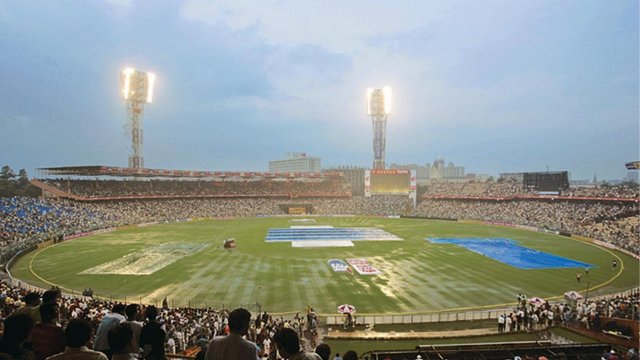On the Road to Mandalay, Kipling’s Tommy met a Burma girl a-sitting by the old Moulmein Pagoda looking lazy at the sea. That was in the 1880s during the Third Anglo-Burmese War.
In Calcutta, a hundred years later, on any given evening, it was difficult to avoid meeting ladies of negotiable affection a-sitting by the old Prome Pagoda looking lazy at the Hooghly. They infested Eden Gardens after dark.
If you sat on a bench, within 10 minutes, a woman would plonk herself next to you and ask for a light. As you lit her cigarette (or biri) she would pop the question. Most were hags but I know several middle-aged men who recall knee-tremblers by the Pagoda through a haze of nostalgia.
That was before they rebuilt the stadium and cut off the river view from the park behind it. In fact, the cricket ground is just part of the complex that bears the name of Eden Gardens, though it is, of course, by far the largest part.
The Brits who built Calcutta cultivated a bucolic streak. Lord Linlithgow was known as ‘Linlith-goru’ because he bred cattle (goru). Lord Auckland’s sisters sublimated their spinster energies into landscape gardening. The Misses Eden planted trees, and had an artificial lake dug on the banks of the river, within an easy stroll of the Raj Bhaban.
In the 1850s, after the Second Burma War, a wooden pagoda was transplanted from Prome to the lake. It looked in bad shape but the original material must have been termite-proof Burma teak since it has survived 150 years of neglect.
Eden is in the most beautiful part of Calcutta. Between river and maidan, there’s the stately High Court, the weird Pepperpot of the Gwalior Monument, the jetties, the squat Fort William and finally, the gorgeous racecourse.
Circa 1910, Raphael Tuck & Sons released its ‘Oilettes’ of Calcutta — postcards reproduced from commissioned oil paintings. Tuck’s perspectives of Eden were very much recognisable until the 1980s when the stadium was rebuilt with the 1987 World Cup Final in mind.
The Gardens used to be open 24 hours. Through the day, barristers strolled around during court recess. In the early evenings, it was populated by elderly folks and courting couples.
An hour or so after dark, it was open season. The sex-workers of Eden Garden were the only Calcuttans who cribbed when there was a Test or Mohun Bagan played East Bengal, a stone’s throw away. Vast crowds would then spill over into the park and ruin business.
After the river view was cut off, the attractions of the lake, the pagoda and the conveniently located benches remained.
The modern Club House and the high tiers changed the cricketing conditions as well. One key factor had always been the river breeze. Every time it freshened, Bedi and Prasanna could swirl it, Chandra would gain a yard of pace and later, Kapil would swing it. Even Roger Binny swung it on occasion. After 1987, there was no breeze and Eden became a typical sub-continental slow turner.
I’ve always felt the concrete seats contributed to crowd volatility. Even on a mild winter afternoon, those seats got bloody hot. You stood and cursed the fat cats in the pavilion. The chaps behind stood and cursed you. Everybody made unprintable jokes about burnt posteriors. People chucked orange peel at the coppers.
If India was doing okay, one continuous rumble would rise to a crescendo at delivery. If India was doing badly, the crowd stood in stony silence. And quite often, a bad-tempered crowd transformed into a mob. The World Cup semis in 1996 was appalling. The final day of the Asian Championship Test versus Pakistan was worse. It was played out before empty stands after violence erupted as Shoaib Akhtar blocked and ran out Tendulkar.
They’re going to replace the concrete with plastic seats, so cooler bottoms may mean cooler heads. But violence always lurks in the background at the Maidan. It is Calcutta’s only lung and everybody fights for the right to use it. The book fair causes a huge ruckus. A few months ago, a teenager died when two informal cricket clubs clashed over the right to use the same small patch of turf.
They’ve closed down the park and locked the gates now because of “security problems”. The flesh trade is still very much there. But the action has relocated to the wide-open Maidan.
Such a pity — what is a great metro without its dark underbelly? The Maidan is in no wise as bad as Central Park is reputed to be and certainly it’s safe during the day. On a winter’s day, you can catch a tram on the Kidderpore-Esplanade route or hop onto the Circular Railway or simply leg it from Esplanade to Eden Gardens and back. You’ll have a good time — despite the lack of opportunity for knee-tremblers.




